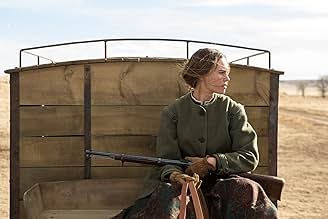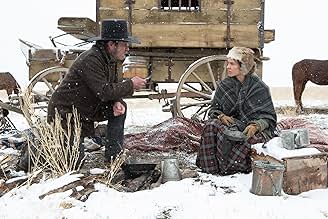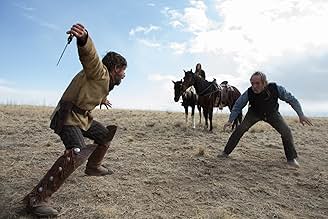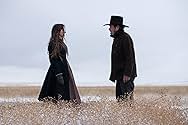Tre donne che sono state fatte impazzire dalla vita dei pionieri devono essere trasportate in tutto il paese da una donna pia e indipendente.Tre donne che sono state fatte impazzire dalla vita dei pionieri devono essere trasportate in tutto il paese da una donna pia e indipendente.Tre donne che sono state fatte impazzire dalla vita dei pionieri devono essere trasportate in tutto il paese da una donna pia e indipendente.
- Regia
- Sceneggiatura
- Star
- Premi
- 5 vittorie e 14 candidature totali
Recensioni in evidenza
December 19, 2014
A homesman is someone tasked to bring people back to their homes. In this film, the people that needed safe transport are three mentally- disturbed women. Mary Bee McCuddy, a plain but hardy spinster, volunteered to be their homesman. Along the way, she rescues a old man Thomas Briggs from being hung by vigilantes and conscripts him to help her with her mission in exchange for saving his life. Together, they gather the three ladies and escort them from Nebraska homes across the dangerous Midwest prairie to a safe haven in Iowa.
Hilary Swank is an actress who had already won a couple of Oscars for playing strong women who had taken on masculine roles in life -- Brandon Teena in "Boys Don't Cry" and Maggie Fitzgerald in "Million Dollar Baby". As Mary Bee McCuddy, a pioneer lady who bravely accepts a task only men are expected to do, Swank again goes on the same award-baiting path. The movie worked so well when Swank was on screen. She was absolutely compelling in this offbeat role as if this was written with her in mind. The movie was not the same when her character was not there.
Tommy Lee Jones is one actor who, as of late, had seemingly been confined to playing curmudgeonly and cantankerous old men, and his Briggs here is not any different. This film is only Jones' second directorial effort since his critically-acclaimed debut in "Three Burials of Melquiades Estrada" back in 2005. As director, he was very generous to his lead female star Swank, and always gave way to let her shine. As actor, he does consistently as he is expected but this role of a grumpy old outlaw seems too familiar for him already. He wisely played Briggs with some self-deprecating humor to break the tendency of the story to become monotonously bleak.
There were some remarkable cameos from other award-winning or nominated stars in much smaller roles. John Lithgow is his usual capable self playing the Reverend Dowd who reluctantly sends McCuddy off on her task. Hailee Steinfeld plays 16-year old Tabitha Hutchinson to whom Briggs offers a surprising proposal. James Spader, in his usual over-the-top style, plays condescending hotel owner Aloysius Duffy. And last, but definitely not the least, none other than THE Meryl Streep plays perfectly kind and hospitable Altha Carter, who runs the institution in Iowa the women are headed for. These actors appear on screen for only ten minutes or so, but they leave a lasting impression.
The narrative may have been slow and desolate . However, the unusual situations, disturbing imagery, startling story developments and committed performances by the cast all keep our attention riveted. The cinematography with the muted colors worked well with the windswept landscape of its setting, as much a character in itself. The costumes and production design rang true to its mid-19th century time period. The haunting and unsettling musical score create an atmosphere of bitter emptiness. The insufferably miserable topic is clearly not for everyone. But for those who decide to give it a chance, the rewards will be satisfying. 7/10.
A homesman is someone tasked to bring people back to their homes. In this film, the people that needed safe transport are three mentally- disturbed women. Mary Bee McCuddy, a plain but hardy spinster, volunteered to be their homesman. Along the way, she rescues a old man Thomas Briggs from being hung by vigilantes and conscripts him to help her with her mission in exchange for saving his life. Together, they gather the three ladies and escort them from Nebraska homes across the dangerous Midwest prairie to a safe haven in Iowa.
Hilary Swank is an actress who had already won a couple of Oscars for playing strong women who had taken on masculine roles in life -- Brandon Teena in "Boys Don't Cry" and Maggie Fitzgerald in "Million Dollar Baby". As Mary Bee McCuddy, a pioneer lady who bravely accepts a task only men are expected to do, Swank again goes on the same award-baiting path. The movie worked so well when Swank was on screen. She was absolutely compelling in this offbeat role as if this was written with her in mind. The movie was not the same when her character was not there.
Tommy Lee Jones is one actor who, as of late, had seemingly been confined to playing curmudgeonly and cantankerous old men, and his Briggs here is not any different. This film is only Jones' second directorial effort since his critically-acclaimed debut in "Three Burials of Melquiades Estrada" back in 2005. As director, he was very generous to his lead female star Swank, and always gave way to let her shine. As actor, he does consistently as he is expected but this role of a grumpy old outlaw seems too familiar for him already. He wisely played Briggs with some self-deprecating humor to break the tendency of the story to become monotonously bleak.
There were some remarkable cameos from other award-winning or nominated stars in much smaller roles. John Lithgow is his usual capable self playing the Reverend Dowd who reluctantly sends McCuddy off on her task. Hailee Steinfeld plays 16-year old Tabitha Hutchinson to whom Briggs offers a surprising proposal. James Spader, in his usual over-the-top style, plays condescending hotel owner Aloysius Duffy. And last, but definitely not the least, none other than THE Meryl Streep plays perfectly kind and hospitable Altha Carter, who runs the institution in Iowa the women are headed for. These actors appear on screen for only ten minutes or so, but they leave a lasting impression.
The narrative may have been slow and desolate . However, the unusual situations, disturbing imagery, startling story developments and committed performances by the cast all keep our attention riveted. The cinematography with the muted colors worked well with the windswept landscape of its setting, as much a character in itself. The costumes and production design rang true to its mid-19th century time period. The haunting and unsettling musical score create an atmosphere of bitter emptiness. The insufferably miserable topic is clearly not for everyone. But for those who decide to give it a chance, the rewards will be satisfying. 7/10.
The Homesman, written and directed and starring Tommy Lee Jones tells the story of Mary Bee Cuddy (Hilary Swank) a spinster who takes on the responsibility of bringing three insane women to Iowa where they can be taken care of.
She saves or spares the life of George Briggs (Tommy Lee Jones) and enlists him on her arduous five week journey.
When you see Hilary Swank and Tommy Lee Jones, you know the acting is going to be stellar. The parts of the insane women, Arabella Sours (Grace Gummer), Theoline Belknapp (Miranda Otto), Gro Svendsen (Sonja Richter) because of the great directing remained the focus while being secondary characters. The movie had a Shakespearean feel to it and that is a great compliment. These ladies portrayed insanity, believably and that takes serious dedication and acting ability.
"The Homesman" was a tragedy and because of it, some people might not be able to pallet the story; there were some shocking attention grabbing scenes that the average viewer might not be prepared for. Those scenes, to me, were great examples of a different time, a time when life was hard and people died.
The Homesman is a story that sits with you and makes you thankful for many things, even if it just the shoes on your feet.
She saves or spares the life of George Briggs (Tommy Lee Jones) and enlists him on her arduous five week journey.
When you see Hilary Swank and Tommy Lee Jones, you know the acting is going to be stellar. The parts of the insane women, Arabella Sours (Grace Gummer), Theoline Belknapp (Miranda Otto), Gro Svendsen (Sonja Richter) because of the great directing remained the focus while being secondary characters. The movie had a Shakespearean feel to it and that is a great compliment. These ladies portrayed insanity, believably and that takes serious dedication and acting ability.
"The Homesman" was a tragedy and because of it, some people might not be able to pallet the story; there were some shocking attention grabbing scenes that the average viewer might not be prepared for. Those scenes, to me, were great examples of a different time, a time when life was hard and people died.
The Homesman is a story that sits with you and makes you thankful for many things, even if it just the shoes on your feet.
The Homesman is a watchable film depicting the old west in a more true, and less glorious, fashion that most westerns. At first it is confusing, with flashbacks to explain the story, but later it becomes clear.
Prarie madness sets in and three women are slated to be returned Back East. The problem is that one of the three "responsible" men is unwilling to step up, so a woman volunteers. She is strong and courageous, more than most men, but isolated and desperate for a husband because she is "bossy, and plain as an old tin can."
Her ultimate fate is incongruous, completely at odds with her character. A willful suspension of disbelief is required at this point.
Solid performances by Swank, Jones, Lithgow, and the actress who played the madwomen make it entertaining, if a bit long.
Prarie madness sets in and three women are slated to be returned Back East. The problem is that one of the three "responsible" men is unwilling to step up, so a woman volunteers. She is strong and courageous, more than most men, but isolated and desperate for a husband because she is "bossy, and plain as an old tin can."
Her ultimate fate is incongruous, completely at odds with her character. A willful suspension of disbelief is required at this point.
Solid performances by Swank, Jones, Lithgow, and the actress who played the madwomen make it entertaining, if a bit long.
The Homesman, about a 31 year old (un-married/childless) woman (Hilary Swank) who takes up the challenge of bringing three crazed women across the Nebraska plains over five weeks with the help of a deserter-drifter left for dead (Jones), is in some ways meant to be a real Feminist Western (with a capital 'F'), and not in the way that a silly work like The Quick and the Dead was with Sharon Stone. Here, it's much more about depicting a time and place that was quite bleak and desolate and, in some spaces, without much hope. Ultimately Tommy Lee Jones, through the novel it's based on, sees a little more light at the end of the tunnel for his protagonist than, say, Eastwood did in Unforgiven. But it's a combination of things it's about, and emotionally the film does work quite well, in particular in the relationship that unfolds between the two leads.
If you're curious to see a western that has the love of the plains of the West visually speaking ala Ford, but has the dark contours of someone like Mann - and added to that those super dirty production designs and character realizations from Spaghetti Westerns - this might be it, at least up to a point. It's so unrelentingly dark in how it looks on at the deteriorating mental states of these women, and the desperation in the journey for Jones and Swanks' characters, that the few moments of humor are rather surprising - and welcome - especially when Jones first appears to Swank on the noose and the horse. It's the kind of scene that shows this actor, well into his 60's and pushing 70, trying something new in a performance (if only for a scene or two).
It's got a cast that is practically distracting for the who's who that shows up, mostly for one scene a piece: James Spader, Tim Blake Nelson, John Lithgow, William Fichtner, Meryl Streep (!) and Hailee Steinfeld (who appears almost to have wandered from the True Grit set to this one). There's so much going for the Homesman that it's a shame the script is uneven, and there's a plot twist two thirds of the way through that is sort of explained but not at all at the same time, and it leaves the film with a gaping tragedy that can never quite be filled. Interestingly, if you watch the behind the scenes on the blu-ray one of the screenwriters mentions the book left things unexplained as well. That might be fine in the book - or perhaps more was explained in other ways - but it still doesn't work, and what Jones goes for in awe-inspiring shots he leaves behind with some muddled story beats.
Nevertheless, The Homesman is a good Western, a solid western digging into the roots of the genre and mixing the unsavory and horrifying (not like a horror movie, just some repellant images at times, but for a point), though whether one will want to return to it like other, better Westerns is another story. It's the kind of picture I can't put down for its artistry, even if things can be looked at more critically, which may explain why it didn't find its way through the End-of-Awards-time (albeit it was accepted at Cannes).
If you're curious to see a western that has the love of the plains of the West visually speaking ala Ford, but has the dark contours of someone like Mann - and added to that those super dirty production designs and character realizations from Spaghetti Westerns - this might be it, at least up to a point. It's so unrelentingly dark in how it looks on at the deteriorating mental states of these women, and the desperation in the journey for Jones and Swanks' characters, that the few moments of humor are rather surprising - and welcome - especially when Jones first appears to Swank on the noose and the horse. It's the kind of scene that shows this actor, well into his 60's and pushing 70, trying something new in a performance (if only for a scene or two).
It's got a cast that is practically distracting for the who's who that shows up, mostly for one scene a piece: James Spader, Tim Blake Nelson, John Lithgow, William Fichtner, Meryl Streep (!) and Hailee Steinfeld (who appears almost to have wandered from the True Grit set to this one). There's so much going for the Homesman that it's a shame the script is uneven, and there's a plot twist two thirds of the way through that is sort of explained but not at all at the same time, and it leaves the film with a gaping tragedy that can never quite be filled. Interestingly, if you watch the behind the scenes on the blu-ray one of the screenwriters mentions the book left things unexplained as well. That might be fine in the book - or perhaps more was explained in other ways - but it still doesn't work, and what Jones goes for in awe-inspiring shots he leaves behind with some muddled story beats.
Nevertheless, The Homesman is a good Western, a solid western digging into the roots of the genre and mixing the unsavory and horrifying (not like a horror movie, just some repellant images at times, but for a point), though whether one will want to return to it like other, better Westerns is another story. It's the kind of picture I can't put down for its artistry, even if things can be looked at more critically, which may explain why it didn't find its way through the End-of-Awards-time (albeit it was accepted at Cannes).
I enjoy a good western but it would not be fair to this Tommy Lee Jones production to classify it as such without emphasizing the film is more than just a wagon trail journey of two unlikely characters across the rough and unforgiving western terrain. No, it is the story of two unlikely characters, a single and strong willed farmer named Mary Bee Cuddy played by Hilary Swank and a thieving drifter named George Briggs played by Tommy Lee Jones who agree to transport three women by wagon with real psychiatric (madness) problems from Nebraska to Idaho.
There have been hundreds of relatively good westerns produced in the past half century where the hero and heroine remain strong and stoic whilst riding through the barren lands their suits and dresses remain pressed and in pristine condition while their hair is coiffed perfectly, and miraculously the heroine's makeup never dries, cracks or runs. Well such is not the case in the Homesman.
Hilary Swank has never been afraid to shed the glamor of Hollywood and for her role as the stubborn, single, and capable farmer Mary Bee Cuddy the potential suitors that she asks to marry her turn her down and explain that she is far too plain looking, sexless, and too controlling in nature. So Mary Bee Cuddy agrees to make the arduous journey across the western plains maybe in the hope of finding a suitor in Idaho as she has run out of potential suitors in Nebraska and seems to be losing hope in raising a family on her own farm in Nebraska.
As Mary Bee Cuddy commences her journey she comes across someone even more homely and desperate than herself in the name of aging drifter George Briggs who is within minutes of losing his life at the end of a rope for illegally claiming mining rights to another persons staked property. The terms set forth by Mary Bee Cuddy before she will agree to free George Briggs from his futile situation and imminent death by hanging are simple. He must first agree to travel across the western plains of Nebraska to assist Mary Bee Cuddy in the transportation of three insane women to a church in Idaho where they will receive the care and attention they will require to survive.
And so the two hardened caretakers and their three insane passengers set out on their journey which I found to be not like any other western I had previously seen. This is not a humorous and light hearted western but a tough, grueling, and sad journey with what I was surprised provided unexpected results. Some people may not be happy with the last 30 minutes of this feature film, but this is actually where writer/actor/director Tommy Lee Jones hooked me with what I felt was a good feature film that ended strongly.
There are numerous cameos throughout the film including standout performances by Tim Blake Nelson as a lonesome cowboy, John Lithgow as Reverend Dowd, and Jesse Plemons as a derelict husband to one of the insane women. Look for mother Meryl Streep in Idaho as the Reverends wife Altha Carter who enjoys sharing the screen with her real life daughter Grace Gummer who plays one of the three insane women Arabella Sours.
I give the film a good 7 out of 10 rating.
There have been hundreds of relatively good westerns produced in the past half century where the hero and heroine remain strong and stoic whilst riding through the barren lands their suits and dresses remain pressed and in pristine condition while their hair is coiffed perfectly, and miraculously the heroine's makeup never dries, cracks or runs. Well such is not the case in the Homesman.
Hilary Swank has never been afraid to shed the glamor of Hollywood and for her role as the stubborn, single, and capable farmer Mary Bee Cuddy the potential suitors that she asks to marry her turn her down and explain that she is far too plain looking, sexless, and too controlling in nature. So Mary Bee Cuddy agrees to make the arduous journey across the western plains maybe in the hope of finding a suitor in Idaho as she has run out of potential suitors in Nebraska and seems to be losing hope in raising a family on her own farm in Nebraska.
As Mary Bee Cuddy commences her journey she comes across someone even more homely and desperate than herself in the name of aging drifter George Briggs who is within minutes of losing his life at the end of a rope for illegally claiming mining rights to another persons staked property. The terms set forth by Mary Bee Cuddy before she will agree to free George Briggs from his futile situation and imminent death by hanging are simple. He must first agree to travel across the western plains of Nebraska to assist Mary Bee Cuddy in the transportation of three insane women to a church in Idaho where they will receive the care and attention they will require to survive.
And so the two hardened caretakers and their three insane passengers set out on their journey which I found to be not like any other western I had previously seen. This is not a humorous and light hearted western but a tough, grueling, and sad journey with what I was surprised provided unexpected results. Some people may not be happy with the last 30 minutes of this feature film, but this is actually where writer/actor/director Tommy Lee Jones hooked me with what I felt was a good feature film that ended strongly.
There are numerous cameos throughout the film including standout performances by Tim Blake Nelson as a lonesome cowboy, John Lithgow as Reverend Dowd, and Jesse Plemons as a derelict husband to one of the insane women. Look for mother Meryl Streep in Idaho as the Reverends wife Altha Carter who enjoys sharing the screen with her real life daughter Grace Gummer who plays one of the three insane women Arabella Sours.
I give the film a good 7 out of 10 rating.
Lo sapevi?
- QuizGlendon Swarthout's novel was published in 1988. Paul Newman owned the rights, and wanted to direct the film himself. After several failed scripts, he gave up.
- BlooperDuring the Indian attack, every shot of the carriage has mountains in the background. The road from Nebraska to Iowa is nowhere near any mountains.
- Citazioni
George Briggs: Are you an angel?
Mary Bee Cuddy: You're not dead.
George Briggs: Help me. Will you help me? For God's sake.
- ConnessioniFeatured in Film '72: Episodio datato 19 novembre 2014 (2014)
- Colonne sonoreRosalie The Prairie Flower
Music & Lyrics by George Frederick Root (as George Fredrick Root)
Performed by Hilary Swank
I più visti
Accedi per valutare e creare un elenco di titoli salvati per ottenere consigli personalizzati
- How long is The Homesman?Powered by Alexa
Dettagli
Botteghino
- Budget
- 16.000.000 USD (previsto)
- Lordo Stati Uniti e Canada
- 2.429.989 USD
- Fine settimana di apertura Stati Uniti e Canada
- 45.433 USD
- 16 nov 2014
- Lordo in tutto il mondo
- 3.819.421 USD
- Tempo di esecuzione2 ore 2 minuti
- Colore
- Mix di suoni
- Proporzioni
- 2.39 : 1
Contribuisci a questa pagina
Suggerisci una modifica o aggiungi i contenuti mancanti











































